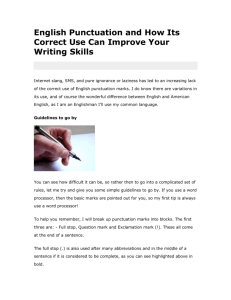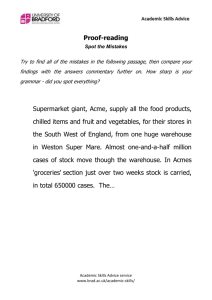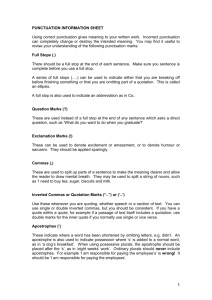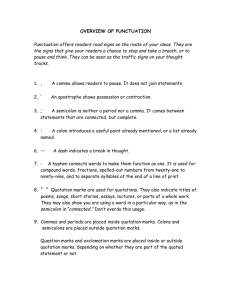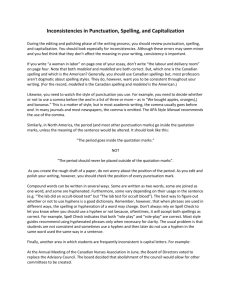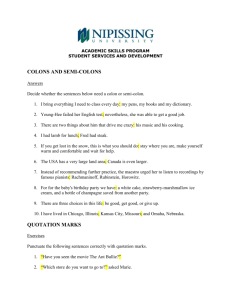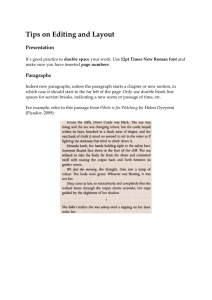Punctuation - Tunica County School District
advertisement
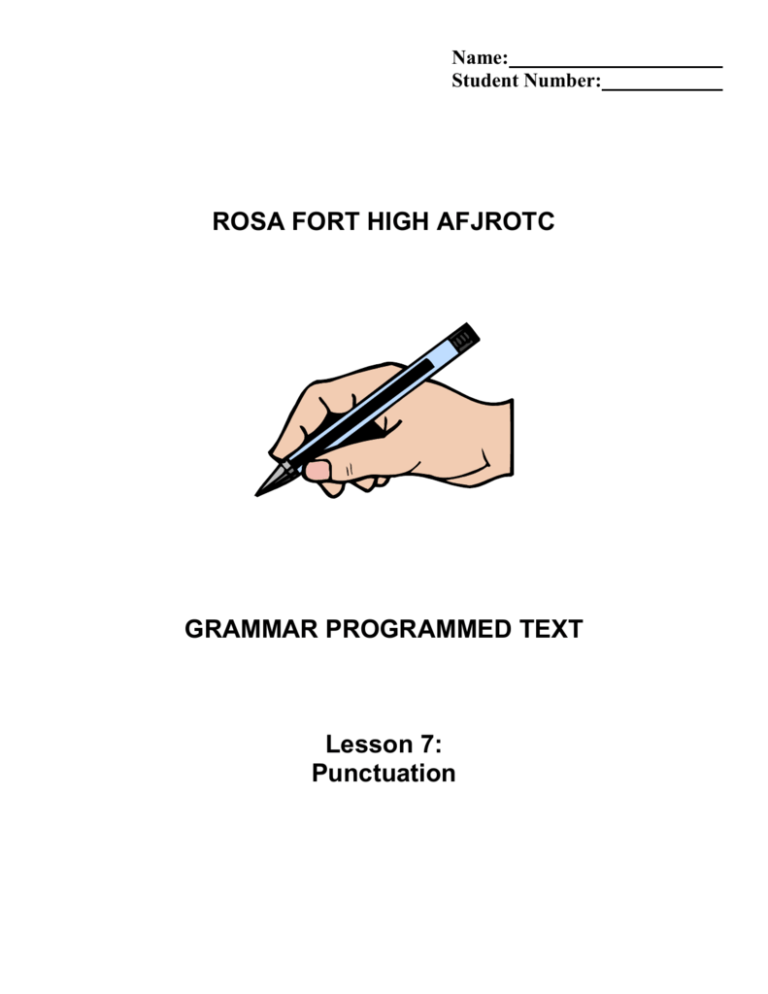
Name: Student Number: ROSA FORT HIGH AFJROTC GRAMMAR PROGRAMMED TEXT Lesson 7: Punctuation INTRODUCTION You can maximize your learning from this programmed text by following a few simple steps. First, take a quick scan over the layout of the document. You’ll notice that this lesson is divided into individual sections starting with a Reading Assignment, followed by a few Review Questions, and concluded with Answers to Review Questions in the back. Once you are familiar with the layout, complete the reading assignment and then answer the corresponding questions (using pen or pencil) to the best of your ability (choose the correct response, complete the sentence, fill in the blank, etc.). Check your work after answering all the questions. If you find that you’ve made a mistake, make the appropriate correction and try to determine the reason for your error before continuing with the lesson. If you do not understand the basis for the correct response to a particular question, consult your flight instructor during normal duty hours. Once complete, turn in this programmed text to your flight instructor to certify completion. READING ASSIGNMENT Punctuation Punctuation is a system of symbols or markings which writers use to clarify relationships among words and groups of words. They usually represent stops or pauses. Writers should always use punctuation marks properly. The incorrect use of punctuation can alter the intended meaning of a word or sentence. In addition, punctuation marks should not be used excessively, since they can decrease reading speed and lead to confusion. There are two types of punctuation style: open and closed. Open punctuation involves using only what’s necessary to prevent misreading. Ease in reading is an additional advantage of using this type of punctuation. The trend today is to use open punctuation. This is the style recommended for Air Force writers. Closed punctuation involves using what the material grammatically requires. Ironically, in so doing, the meaning may not necessarily be any clearer, and more time is ordinarily needed to read the material. There are nearly twenty frequently used punctuation marks. Some of the more common ones are: A period (.) is used at the end of a sentence that makes a statement. I’ll take the test tomorrow morning. A question mark (?) is used at the end of a direct question. Do you know the most direct route to New York City? An exclamation mark (!) is used at the end of an emphatic declaration. Keep off the grass! A hyphen (-) is used to separate words at the end of lines, to create compound words, and to write numbers. For the past twenty-seven years, thirty-six members of an inter-state fly-by-night paving business have fleeced Montgomery homeowners. A dash (— ) or two hyphens (--) is used to set off parenthetical or related elements. When writing dialogue, it is used to show breaks in thought, or shifts in tone. The Smith triplets--Tom, Dick, and Harry—argued constantly. “How often do I have to tell you not to—” the teacher stopped talking and stared at the floor. A parentheses ( ( ) ) is used to include either material that you want to de-emphasize or does not comfortably fit with the text flow. Six years after her retirement, Esther Franklin (we remember her for deep-dish sweet potato pie) is still spoken of fondly by her co-workers. Six years after her retirement, Esther Franklin is still spoken of fondly. (We remember her for her deep-dish sweet potato pie.) A bracket set ( []) is used either to include explanatory words within quoted language or to enclose changed letters or words within a quotation. Steve Smith, the Regional Director of Marketing, explained that Roger Right, a new sales manager [at Smithco headquarters] will be responsible for issuing bonuses. Right credited his former employer with “ guiding [his] career advancement.” An ellipsis (…) is used when you’re quoting some material and want to omit several words. The dance contest features talented couples from Hartford who are attending classes at Harvard. The dance contest features talented couples …attending classes at Harvard. A slash (or virgule) is used to indicate a choice between the words it separates. The stop/go traffic pattern wrought havoc with the small community’s business district. An asterisk (*) refers readers to a footnote at the bottom of a page or replaces words considered unprintable. It was fortunate that the microphone was off when the moderator called the guest an *** during yesterday’s live news program. A display dot (at far left) is used to emphasize specific items that are parallel in grammatical structure. They precede either complete or incomplete sentences. The lieutenant’s speech followed a tried and true pattern: Tell ‘em what you’re going to tell ‘em Tell ‘em Tell ‘em what you told ‘em Italics (italics) are used to distinguish the titles of whole published works, the names of ships, submarines, aircraft, and spacecraft in printed material. Italicize the name only, not initials or numbers preceding or following the name. East of Eden the best ideas C5-A Galaxy An underscore ( _ ) is used in place of italics to identify titles of whole published works and to distinguish the names of ships, planes and spacecraft when italics cannot be used (i.e. typewriter, handwritten documents). The underscore is also used to denote a word simply as a word and not for its meaning. Time magazine F-4 Phantom time and thyme are homonyms The remainder of this PT will focus on the five most common punctuation marks. Quotation marks. (“ ”) set off material that represents quoted or spoken language. Double quotation marks are used to enclose direct quotations. Single quotation marks enclose a quotation within a quotation. Always capitalize the first word of a direct quotation because it’s the first word of someone’s sentence. “The best things in life are free,” said the seasoned shoplifter. “The purpose of this study,” explained the researcher, “is to analyze the term ‘hoorah.’” Jack said to Diane, “That is your third piece of pie.” Quotation marks are used around the titles of works that are part of larger works. “Grammar” is the first chapter in the book entitled Better English-Better Salary. Quotation marks may be used to enclose words used in a special sense. The most famous member of the “Hollywood rat pack” was Frank Sinatra. It is important that other marks of punctuation are placed in the proper position when used with quotation marks. An exception occurs when a source reference immediately follows a quotation. In this instance, a comma or period is placed after the reference. Commas and periods are placed inside quotation marks, while colons and semicolons are placed outside the quotation marks. “Life is sweet,” said the confectioner. The research assistant termed the find “incredible” (Miller 6). A decade ago, the team’s motto was “Refuse to Lose”; today, however, it’s “Win Again.” Dashes, question marks, and exclamation points are placed inside quotation marks only if they belong to the quotation. Otherwise, place them outside the quotation marks. “Get out of here!” said the disgruntled manager to his new employee. He called me “obtuse”! A colon ( : ) is used before a list, a concluding explanation, an appositive, or a formal quotation. He had three passions: reading, writing, and speaking. Public radio programming is definitely eclectic: it includes music, talk shows, and newscasts Life has only one major drawback: death. The historian had a great explanation: “A lengthy explanation would then follow.” A colon is also used to separate titles, subtitles, and subdivisions of time. Hannibal: A History of His Tactics 7:26 PM A semicolon (;) is used to sort out items or to separate closely related independent clauses. There were delegates from Helsinki, Finland; Moscow, Russia; Paris, France; and Turin, Italy. He rarely goes outside during the hot weather; he’s afraid he’ll get a sunburn. An apostrophe (’) is used to create possessive forms, contractions, and some plural forms. The airman’s uniform She should’ve four C’s SOS’s A comma (,) is used to separate elements in a series of three or more things, including the last two. A comma may also be used with a conjunction to connect two independent clauses. “Eat, drink, and be merry,” said the Mardi Gras coordinator. She stole the inbound pass, but lost the ball while dribbling on a breakaway. Use a comma to set off introductory elements. It is permissible to omit the comma as long as it does not leave the reader confused or hinder the sentence’s readability. Holding his eating utensils improperly, he had the eyes of the dinner guests upon him. For some the day begins before dawn. (The meaning of this sentence is fuzzy.) For some, the day begins before dawn. (The comma provides clarification.) Use a comma to set off parenthetical expressions. The comma separates the essential parts of the sentence from the additional (and oftentimes expendable) parenthetical information. The non-essential elements are underscored in the provided example. The Richford Office Tower, which houses thirty-three business suites, occupies a city block. When both a city’s name and that city’s state or country’s name are mentioned together, the state or country’s name is treated as a parenthetical element. When the state becomes a possessive form, this rule is not followed. Also, when the state or country’s name becomes part of a compound structure, the second comma is dropped. He moved here from Cleveland, Ohio, last year. He is Cleveland, Ohio’s favorite son. The Coca-Cola Corporation, an Atlanta, Georgia-based company, became international this week. Use a comma to separate coordinate adjectives. If you can put an and or a but between the adjectives, a comma will probably belong there. I drive a very old, run-down vehicle. = I drive a very old and run-down vehicle. Use a comma to set off quoted elements. Generally, a comma will separate the quoted material from the rest of the sentence explaining or introducing the question. Arguing the minority opinion, Justice Philips said, “The legal principle here is one of quality and not of quantity.” If the attribution of a quoted element comes in the middle of the quotation, then two commas will be necessary. Commas are not necessary if the quoted element is introduced by the word that or is embedded in a larger structure. “I understand,” said Frank matter-of-factly, “that you actually enjoy embarrassing others.” Justice Philips said that “the legal principle...” He was always heard to say “Cool” if he enjoyed something. Instead of a comma, use a colon to set off explanatory or introductory language from a quoted element that is either formal or long. Justice Philips had this to say about the exploitation of children in the workplace: “We must endeavor…” A comma is used to set off phrases that contrast. If the phrase begins with the word but, the comma may be omitted. The vacation was incredibly enjoyable, but terribly expensive. A comma should be used between the names of a city and state, a date and the year, a name and a title when the title follows the name and in long numbers. Richard L. Brewster, Director of Marketing, earned in excess of $1,354,789 in salary and bonuses during 1999. The Denver, Colorado native retired July 17, 2000. When the date of a month is included, a comma or a set of commas is necessary. Without the date, the comma is omitted. Dates written in international or military format require no commas. July 17, 2000, was the day Richard L. Brewster retired. July 2000 was a month filled with retirements. Richard L. Brewster retired 17 July 2000. Although we have provided many instances where the use of commas is appropriate, there are still others. The single largest problem most writers have with comma usage is a tendency toward overuse. When in doubt, comma placement should be decided upon only if one of the above specific rules can be applied. This concludes the reading assignment portion of the PT on punctuation. Now that you’ve had an opportunity to review punctuation along with its various forms and uses, it’s time for you to take it to the next level! The following series of questions will reveal whether you have achieved the desired level of expertise with punctuation or if you need further study in this area. As explained in the introduction, the correct answer for each question is located at the back for your ready reference. Consult the answer bank only after you have completed all questions. If you miss a question, read the provided rationale and go back over the corresponding section of the reading assignment if necessary. Do your best to thoroughly understand this material. If anything is not clear to you, ask your instructor for assistance. Good luck! REVIEW QUESTIONS Determine if each sentence below is correctly or incorrectly punctuated. If correct, write the word “correct” on the line provided. If incorrect, rewrite the sentence using correct punctuation. 1. “Your dental appointment is for 1300,” said the clerk. 2. The instructor said, “Your performance has greatly improved.” 3. “Eat your food slowly, said her mother, and you’ll enjoy it more.” 4. Tom said, “I’ll be home for Christmas.” 5. Jack said, “you can use the car, Mike.” 6. Private Smith always said, “A stitch in time saves nine”. 7. A decade ago, the team’s motto was “Refuse to Lose;” today, however, it’s “Win Again.” 8. “A blowout at high speed,” he said, “may prove fatal.” 9. I’m telling you John that it’s cool to wear a sweater with khaki shorts. 10. Greensleeves is the third cut on the new album, Best of American Folk. Rewrite each of the sentences below to ensure they are punctuated correctly. 11. Richard L. Brewster, Director of Marketing earned in excess of $1354789 in salary and bonuses during 1999. The Denver Colorado native retired July 17, 2000. 12. As a three-level apprentice she had incredible job knowledge. 13. He always ate dinner promptly at 7,30 PM. 14. There were delegates from Helsinki, Finland, Moscow, Russia, Paris, France, and Turin, Italy. 15. He had three passions---reading, writing, and speaking. 16. Johns wife, Julia, and her brothers friend, Al, shouldve heeded the SOSs sent by the hikers prior to their climbing the peak during winter ANSWERS TO REVIEW QUESTIONS 1. correct 2. correct 3. “Eat your food slowly,” said her mother, “and you’ll enjoy it more.” (Since the attribution comes in the middle of the quotation, two commas are needed.) 4. correct 5. Jack said, “You can use the car, Mike.” (The word you needs to be capitalized since it’s the first word of a direct quote.) 6. Private Smith always said, “A stitch in time saves nine.” (A period or comma always precede the quotation marks.) 7. A decade ago, the team’s motto was “Refuse to Lose”; today, however, it’s “Win Again.” (Colons and semi-solons are always placed outside the quotation marks.) 8. correct 9. I’m telling you, John, that it’s cool to wear a sweater with khaki shorts. (If the name of an addressed person is used in a sentence, it is parenthetical, and must be set off by commas.) 10. “Greensleeves” is the third cut on the new album, Best of American Folk. (Quotation marks are used around the titles of works that are a part of larger works.) 11. Richard L. Brewster, Director of Marketing, earned in excess of $1,354,789 in salary and bonuses during 1999. The Denver, Colorado native retired July 17, 2000. (Use a comma to set off a title following a name, to separate large numbers, and to separate the name of a city and state.) 12. As a three-level apprentice, she had incredible job knowledge. (A comma sets off an introductory phrase.) 13. He always ate dinner promptly at 7:30 PM. (Use a colon to separate the numbers in a time sequence.) 14. There were delegates from Helsinki, Finland; Moscow, Russia; Paris, France; and Turin, Italy. (Use a semi-colon to separate a series of related items.) 15. He had three passions: reading, writing and speaking. (Use a colon before a list.) 16. John’s wife, Julia, and her brother’s friend, Al, should’ve heeded the SOS’s sent by the hikers prior to their climbing the peak during winter. (An apostrophe is used to create possessive forms, contractions, and some plural forms.)

